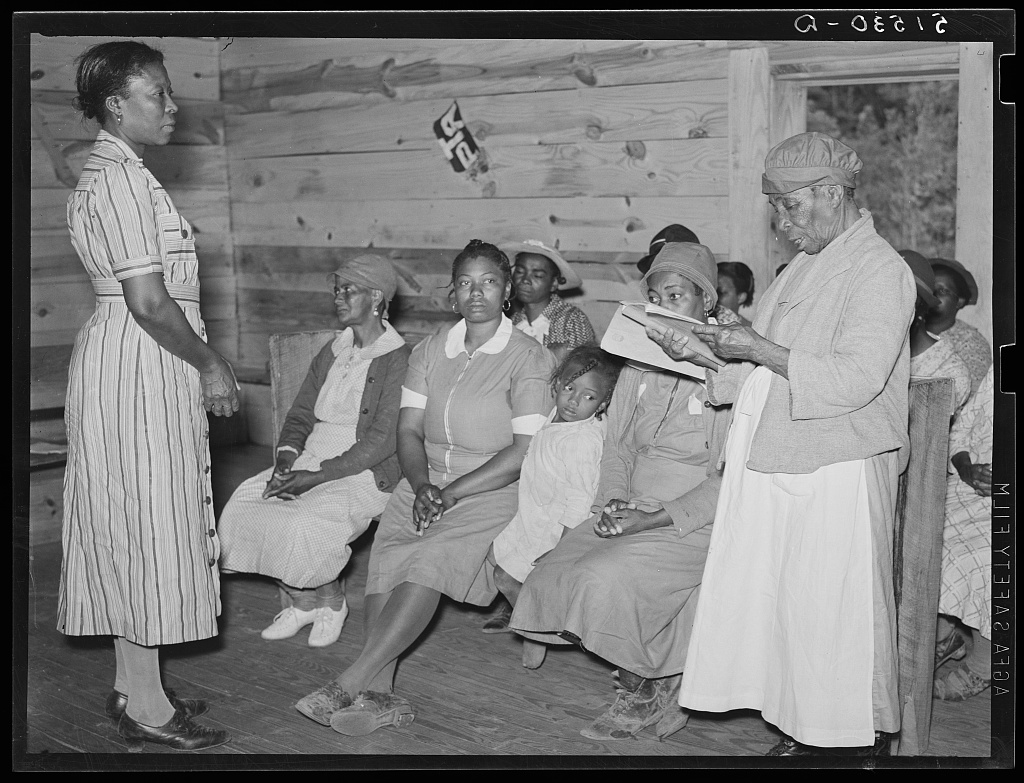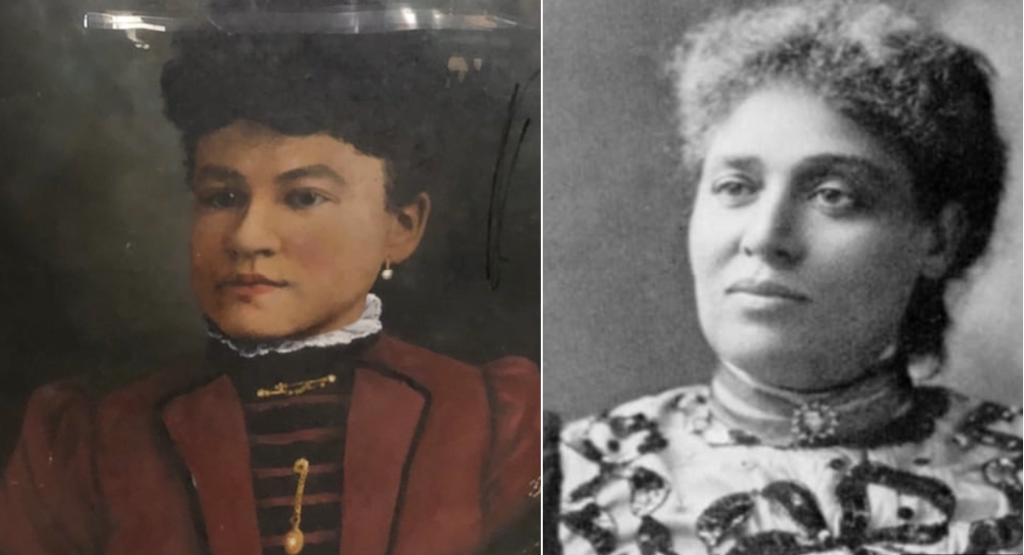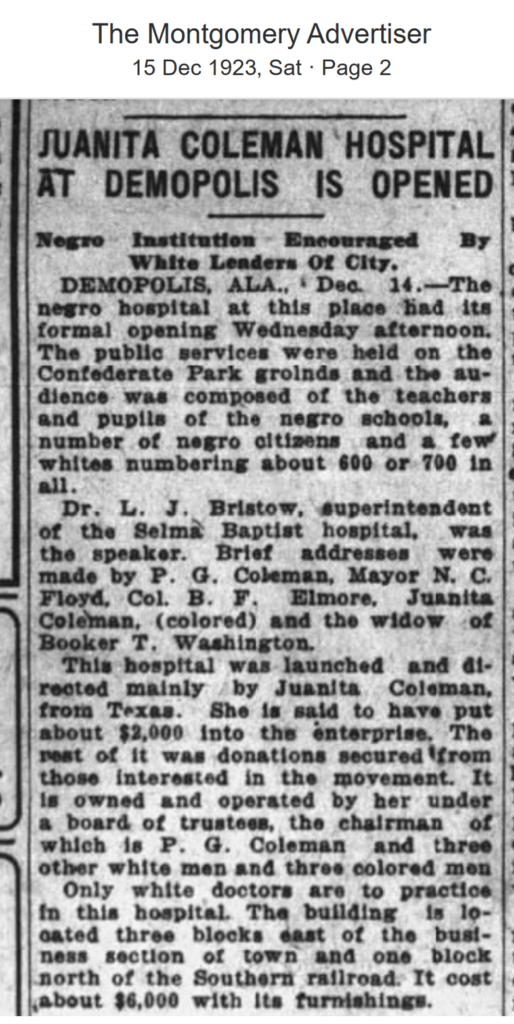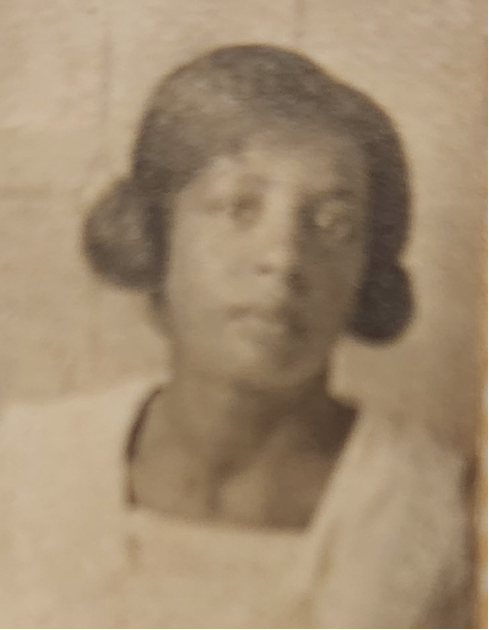Black History
The untold story of a Black woman who founded an Alabama hospital during Jim Crow

100-year-old artifacts discovered in home that once served as hospital for Blacks
- December marks the 100th anniversary of the Juanita Coleman Hospital
- Hospital served Black patients in Demopolis, Alabama during Jim Crow
- Discrimination prevented Black physicians from working at facility
- Hospital artifacts discovered in attic nearly a century later
Mary Jones Fitts and her mother always enjoyed returning home to Demopolis, Alabama. Back in 2010, they were cruising through their old neighborhood when her mother, Mary Ida Calhoun, 85, casually pointed at a one-story blue house on East Washington Street.
“That was the Juanita Coleman Hospital,” said her mother.
Jones Fitts was puzzled. “Who was Juanita Coleman?”
“She was a Black lady from Tuskegee who came to Demopolis and found out there was not a hospital for Black people,” said her mother. “So, she built this hospital.”
This was a life-changing conversation for Jones Fitts. It was the first time her mother mentioned the name Juanita Coleman or that a Black woman founded a hospital in west central Alabama – during the Jim Crow era. The revelation was even more surprising because Jones Fitts is the former director and president of the local Marengo County History and Archives Museum. Black history was her passion and she had absolutely no record of Juanita Coleman.
The revelation inspired Jones Fitts to dig for more information and bring the Juanita Coleman story to life. But in this Alabama community where Black people make up roughly half of the population, Jones Fitts was frustrated that more people did not know this story. She encountered some Black residents who were old enough to remember the Juanita Coleman Hospital but expressed a reluctance to talk about the painful history of discrimination that made an all-Black hospital necessary for survival.
“No more,” Jones Fitts told herself. “It’s time to tell our stories.”
Backstory
Nannie Juanita Coleman was born August 5, 1885, in Temple, Texas. After high school, Coleman studied at The Tuskegee Normal and Industrial Institute in Alabama where she graduated in 1908.
Coleman’s earliest achievements are documented in a few books and research papers. In 1915, at the age of 30, The Tuskegee Institute hired Coleman as the first female home demonstration agent to uplift poor Black families with lessons in agriculture, health, and homemaking.
During her years as a demonstration agent, Coleman had an important mentor by her side – Margaret Murray Washington. Washington was one of the most influential women in America as the principal of Tuskegee Institute and the widow of Booker T. Washington.
Under Mrs. Washington’s guidance, Coleman stages what might have been her most significant achievement. She raised money to secure space and furnishings to fulfill medical needs for the Black community in Demopolis. In 1923, Coleman purchased a house on Washington Street.

Juanita Coleman Hospital dedication

On December 15, 1923, The Montgomery Advertiser announced the opening of the Juanita Coleman Hospital. Approximately 600 people attended the dedication. The event was held in the town’s Confederate Park.
The total cost of the 12-bed facility and the furnishings was $6,000. Hospital superintendent Coleman is credited as the owner and operator who invested $2,000 of her own savings (the equivalent of $35,000 in 2023.) “The rest of the money was secured through donations from those interested in the movement, “according to the Montgomery Advertiser.
Despite her significant financial stake, ownership and naming rights, Juanita Coleman did not have complete autonomy over her hospital operations. Coleman reported to a board of trustees consisting of three Black and four White community leaders.
No Black doctors allowed
In 1923, The Selma Times Journal reported the purpose of the new Juanita Coleman Hospital was to provide care for “colored patients and training of colored nurses.” But there was one catch – Black doctors were not allowed to practice medicine at the hospital. The ban is spelled out in a single sentence near the end of the article “Only White doctors are to practice in this hospital.” The article provides no further explanation or context.
It’s possible that White leaders in Demopolis established discriminatory ground rules around Superintendent Coleman’s hospital as a condition of support or to limit competition between Black and White doctors. It’s also worth noting that a hospital exclusively for Black people also provided an excuse for White hospitals to continue the long-standing practice of denying medical services to Black people.
On the hospital’s fourth anniversary, The Demopolis Times published a thank you letter from Coleman to the community for “splendid” donations and financial help “thus making it possible for us to go a little further,” she wrote.
The struggle to pay bills
Juanita Coleman’s hospital operated on “small fees paid by patients and the generosity of the public”. A remarkable accomplishment, especially during the Great Depression when the hospital temporarily closed its doors. In the spring of 1931, Coleman took out an advertisement in the Demopolis Times and announced the “reopening” of her hospital. This time, she informs readers that the hospital doors will be open to “all licensed physicians.” This appears to be Coleman’s victory in toppling the Black doctor ban.
It’s unknown when the hospital officially closed. The last known newspaper reference to her hospital is a furniture sale announcement published in The Demopolis Times in 1953. At the same time, Coleman was working in Washington D.C. as a counselor at an Industrial school for girls. Newspaper accounts indicate Coleman travelled frequently between Washington D.C. and Alabama.
So far, there has been no documentation of Coleman’s life in the 1960’s. She died in 1973 and was buried in Maryland.
More amazing discoveries
Not long after the 2010 revelation about the Juanita Coleman Hospital, Mary Jones Fitts returned to the blue house on Washington Street. She met the owner, who was unaware of the building’s history. Walking through the front door, Jones Fitts felt like she was stepping back into time. Inside, she noticed a number affixed to each door in the central hallway. They were the actual room numbers original to the hospital.
The discoveries continued several years later, when the homeowner found hospital artifacts in the attic including a white cabinet containing medical instruments. Perhaps the most valuable find was a framed painting of an unidentified woman. The painting bears a strong resemblance to Coleman’s mentor, Margaret Murray Washington, the wife of Booker T. Washington. Both items have been on display at the Marengo County history and archives museum as the only public exhibit of Juanita Coleman’s hospital.

Author’s note: I’ve known for many years that in the 1920’s, my grandmother, Inez Taylor Drake RN was the head nurse at a hospital in Demopolis, Alabama. No one in my family, including my 89-year-old mother, had ever heard of the name Juanita Coleman. This led my family back into our scrapbooks where we found a century-old Demopolis postcard. On the back, my grandmother confirms what we never knew until now: “Sis Coleman introduces me to folks as her head nurse from Texas,” my grandmother wrote home to her younger sister. “Do you reckon I get to be somebody at last.”
Juanita Coleman Legacy
As a historian, Mary Jones Fitts believes she has a responsibility to continue telling the story, especially when she encounters life-long Demopolis residents who have never heard of the Juanita Coleman hospital. “Coleman was a force to be reckoned with,” says Jones Fitts. “She definitely left her mark.”
In addition to the legacy, Jones Fitts also thinks about her own mother who died two years after the Juanita Coleman revelation. What if her mother had remained quiet about this important piece of Black history?
“I wouldn’t be the historian that I am today,” says Jones Fitts. “My mother loved Demopolis. She loved the people that were here. Learning about Juanita Coleman started me on a journey that I am still on today.”
About the author: Carlton Houston is a former journalist, writer and historian. For more history stories, follow Carlton on Instagram @myhistoryvibe
Image Credits: Juanita Coleman listening to one of her pupils read in her adult class Source: Library of Congress.

-

 Featured10 months ago
Featured10 months agoCalifornia Is the First State to Create A Public Alert for Missing Black Youth
-

 Featured9 months ago
Featured9 months agoAfrican American Leaders Stay the Course Amid Calls for President Biden To Bow Out of Race
-

 Featured10 months ago
Featured10 months agoThe Debate Fallout Lands on Both Candidates
-

 Featured9 months ago
Featured9 months agoPresident Joe Biden Decides to Withdraw from the Presidential Race
-

 Featured9 months ago
Featured9 months agoIn One of His Final Speeches as President, Biden Says It’s Time for ‘Fresh Voices’
-

 Featured9 months ago
Featured9 months agoPresident Joe Biden Describes Shooting of Donald Trump As ‘Sick’









